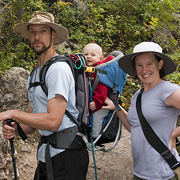First Weekend in Vedauwoo! Part 2
“Vedauwoo filter(s) out the weak, the soft and the spineless, which leaves better company for you.” – Todd Skinner
After dinner on Saturday night Doug and Liz headed home, and Mark and I cuddled up for a windy Wyoming night of camping. On Sunday morning, we had origionally planned to try to get in a training hike for our upcoming climb of the Grand Teton, but we weren’t feeling motivated. Instead, we substituted the long-ish (20 minutes) approach to Plumb Line Crag.
After our arduous journey, through cow pastures and sage brush, we came upon another group of climbers racking up for the climb we were looking for: the infamous Plumb Line (5.9+) itself! Only two of the three climbers in the group planned to climb the route, the third was a friendly girl who had a much nicer camera than I and was pulling out some good stops for some great photos. In deference to her, I ended up not taking any pictures at the cliff. So, I’ll borrow one from MP.com (below).
Plumb Line is a beautiful, perfect, hand crack: 50ft long and slightly overhanging. It’s an old-school 5.9, the difficulty graded back in the days when 5.10 didn’t exist. Mark and I have oogled the climb before, but never attempted it. Today, it was our only plan, so we decided to be patient and hang out while the other group had a go.
We chatted with the first leader, who said their group was from Boulder. The leader described learning to climb years before in SoCal, and that Vedauwoo was giving him a chance to pull out tricks from Joshua Tree that he hadn’t used in a while. His second was a route setter at THE premier bouldering gym in Boulder (the Spot), and he complained a bit that morning that he may have been bouldering too much lately. They both did a great job on Plumb Line, with the leader taking a few worthy falls as he “went for it” on gear!
Mark scrambled around to the rap anchors and worked on setting up a TR for us. This was a little tricky because the crack had a perfect rope-wedging cleft at the top of the crack, and all we had to run the rope over was a hex that was slightly too big. Mark figured it out eventually and then it was our turn to climb!
Mark did a fantastic job, of course. He pulled into the crack and then was on top of the rock in 6 or 7 long, smooth, loping moves. He kept hands and feet in the crack, and had beautiful technique throughout the climb. I, on the other hand, managed to ‘climb two moves and fall’ all the way to the top. Two moves and fall. Two moves and fall. On my second lap I got more into the rythm and was able to string together more than two moves. It almost started to feel good! Or at least I felt like throwing up a little less when I topped out. Mark’s second lap was faster and smoother than his first, and as he rapped off he declared that he would be ready to go for a redpoint the next time we were in the area!
I should mention as we were working Plumb Line, the group of Boulder boulderers had moved to our left, and the route setter had decided to tackle a nasty overhanging off-width Big Pink (5.11b) – one of Bob Scarpelli’s favorites. They borrowed our #4.5 and #6 cams to round out their rack for the menacing 8 inch wide crack.
That guy gave Big Pink a huge fight. He made it about 12 feet up before taking a hard lead fall onto our biggest cam. That’s when something weird happened. The cam had been placed into the crack in the normal manor, with the grip facing horizontally out. When the leader took that big fall, the cam’s lobes dug into the crystaline granite and, at the same time, the whole giant piece of pro rotated 90-degrees as it caught his down-ward fall. There was a huge “CRACK!” and smoke or dust actually came drifting out of the crack. The cam was left in an awful position, with two lobes pressed all the way in and two out like an umbrella.
We all agreed that part of the rock must have cracked under load, and that we had just seen what happens when you fall on a smaller cam, but at a really big, slow scale. Pretty wild. The leader carefully placed the other #6, and hung on it while he worked our cam out of the crack. He then went back to the heavy work of climbing the route, and eventually made it up, as did his second.
Mark and I were interested in trying this offwidth. It had been a long, hard fight for both the Boulder boulderers, and they hadn’t used any heal-toe or chicken wings or our usual methods of offwidth climbing. So, now we have two more goals for Vedauwoo. Redpoint Plumb Line and climb Big Pink!




2 Comments